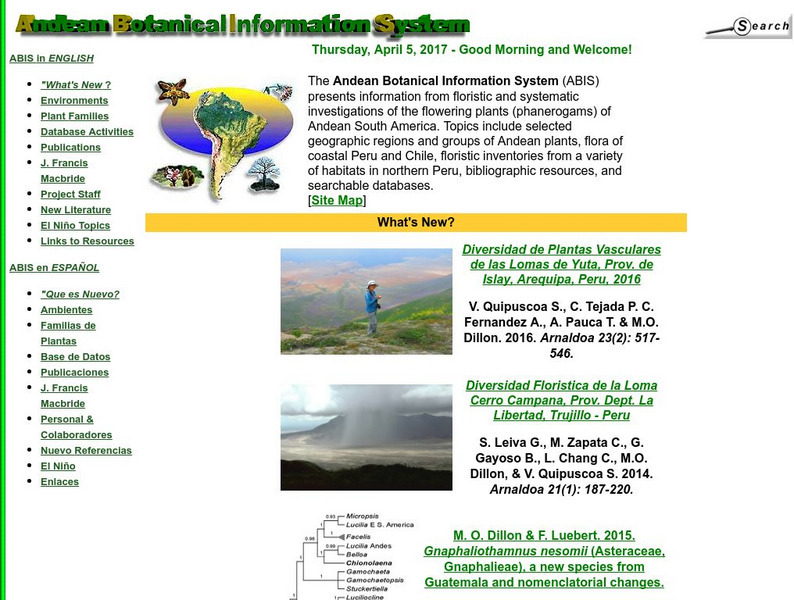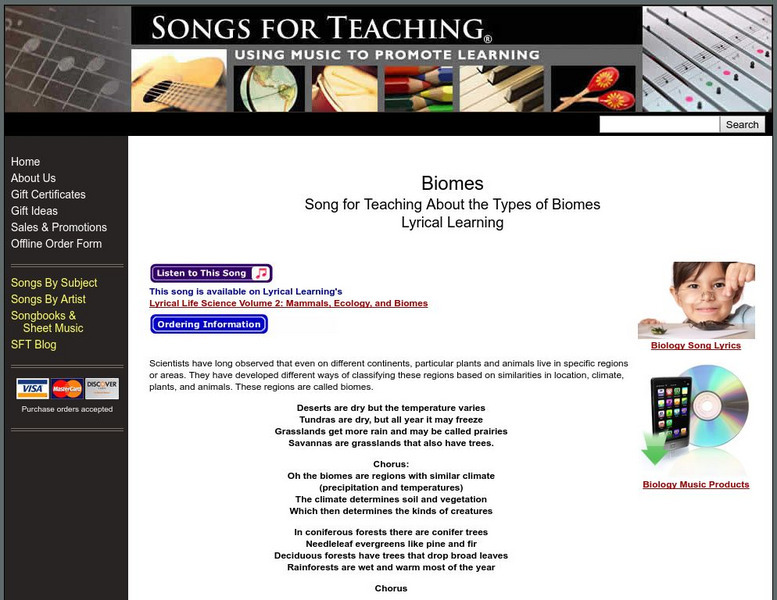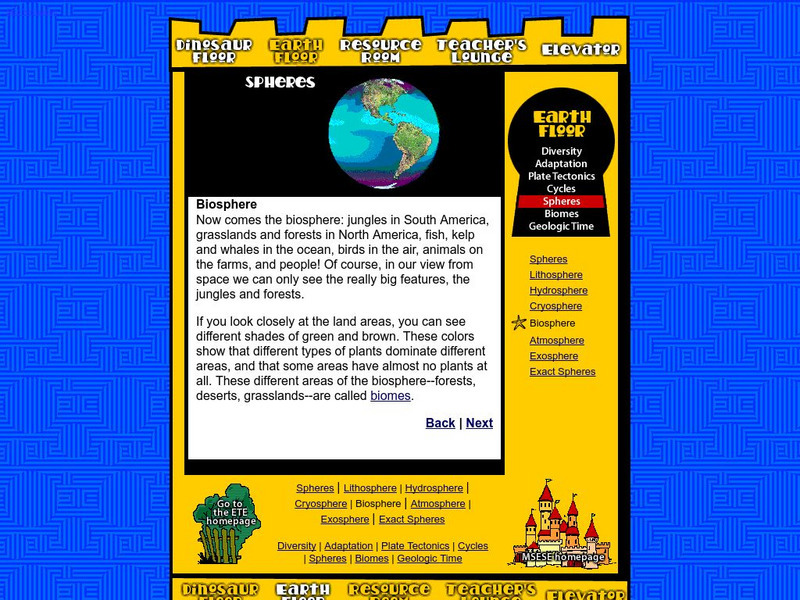Smithsonian Institution
National Museum of Natural History: American Mammals: Mexican Long Nosed Bat
The Mexican long-nosed bat feeds mainly on the nectar and pollen of agaves, and is found in Texas in June and July when the plants are in bloom there. Then it migrates southward into Mexico, where it lives in pine-oak forests and...
Palomar Community College District
Major Biomes of North America
A good review of basic terminology followed by descriptions and pictures of the North American biomes.
Other
Andean Botanical Information System
Great research from the Andean Botanical Information System into the diverse environments and plants of the Andean region of South America, and particularly Chile and Peru. Available in Spanish or English, photographs and written...
Mocomi & Anibrain Digital Technologies
Mocomi: Major Biomes of the World
Covers the major types of biomes: tropical rain forest, arctic tundra, coniferous forest, deciduous forest, desert, grasslands, and mountains.
Discovery Education
Discovery Education: Habitats of the World
This site has a lesson to use to start a unit on biomes and animal habitats. This plan incorporates grasslands, temperate forests, tropical rainforests, deserts, polar ice regions, and tidepools.
Songs for Teaching
Songs for Teaching: Biomes
Use this site to see how many of the animals and plants that your students can remember from each biome after listening to this song.
Songs for Teaching
Songs for Teaching: Types of Biomes
Doug Eldon performs this great song which tells about the different biomes and their characteristics. Great way to begin your unit on the biomes.
Encyclopedia of Earth
Encyclopedia of Earth: Biodiversity
A large collection of articles, news items, photos, slideshows, animations, and scientific reports, all related to biodiversity. Many articles on different ecosystems, e.g., deserts, grasslands, forests, etc. An excellent resource for...
Utah State Office of Education
Utah Science: What Do You Mean, We Are Different?
Across the state of Utah one will observe a variety of environments such as wetlands, desert, and forest. Here are several activities highlighting the many ecosystems found within one state.
Utah Education Network
Uen: Nhmu: Living Food Web
Fourth graders will be able to name some plants and animals that live in Utah's desert, forest or wetland ecosystems.
Curated OER
Bureau of Land Management: Bureau of Land Management
The BLM manages one in every 10 acres of land in the United States, and approximately 30 percent of the Nation's minerals. These lands and minerals are found in every state in the country and encompass forests, mountains, rangelands,...
Other
Introduction to the Biosphere: Characteristics of the Earth's Terrestrial Biomes
From Chapter 9 of a textbook on physical geography that covers the biosphere. Important vocabulary is highlighted and linked to a glossary. It explains the characteristics of a biome, and describes the features of the eight different...
Enchanted Learning
Enchanted Learning: Biomes
Discover the hidden treasures in the different habitats on the earth! The earth is filled with many biomes. Examples of different biomes are listed and include hyperlinks to additional information such as the animals found there.
The Association of the British Pharmaceutical Industry
Abpi: Human and Animal Habitats
An interactive learning game where students answer whether or not certain environments would be suitable for different animals. Printable worksheets are available for review at the end of the activity.
Utah Education Network
Uen: Science Vocabulary Game
Fourth graders will play a review memory game with Utah's Grade 4 Science Standard V vocabulary words during this lesson plan. Words associated with living things and classifications of living things are included in this lesson plan.
San Diego Zoo Global
San Diego Zoo: Antelope
This resource provides extensive information about the antelope, including several photos. [1:08]
Wonderville Media
Wonderville: African Elephants
African elephants are the biggest land animals on the planet, standing up to 13 feet tall and weighing as much as 14,000 pounds. They are even bigger than their elephant cousins in Asia. You can tell them apart because their ears...
Other
Ecological Regions of North America [Pdf]
A helpful map of North America which color codes its 15 ecological regions. Click on the different regions for a brief description of the area. Requires Adobe Reader. [PDF]
Other
Online Expeditions: African Adventure
Use this site to explore several regions of Africa, without having to leave the classroom.
Center for Educational Technologies
Wheeling Jesuit University: Arctic Tundra Biome
Provides text and pictures on the arctic tundra, its animals, plants, and their adaptations.
National Earth Science Teachers Association
Windows to the Universe: Climate Changes With Latitude
A map showing the division of the world into eight biomes based on different climate types around the world. There are links to more information about each biome.
Center for Educational Technologies
Nasa: Classroom of the Future: Spheres: Biosphere
Use this site to learn about the different areas of the biosphere, known as biomes.
Smithsonian Institution
National Museum of Natural History: American Mammals: Southwestern Myotis
Southwestern myotis live in a variety of southwestern mountain habitats, from desert grasslands up into pine and mixed coniferous forest in the United States, and in desert and grassland in Mexico. These bats and two other myotis...



















